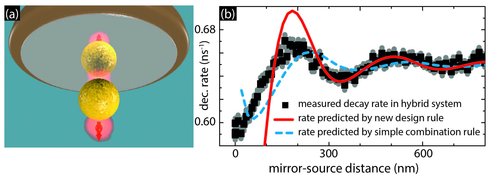May 29, 2013
Scientists throughout the world are developing building blocks to improve the brightness of light sources and therefore the performance of LEDs, lasers and optical information technology. The AMOLF researchers made a new controllable circuit just 500 nanometres in size that combines different photonic building blocks for the first time. Using this circuit, the scientists managed to determine the design rule that governs light emission in such a system. Results of the research were published on May 23, 2013 in the scientific journal Physical Review Letters.
The new system combines the latest developments in nanophotonics. In that discipline physicists investigate how light can be manipulated with materials produced on the nanoscale. For example, researchers manipulate how light is produced in lasers and LEDs, how light propagates in optical chips and how solar cells absorb light. The research of the FOM physicists focuses specifically on improving the emission of light by the smallest quantum light source: a single molecule.
There are many known methods researchers can use to manipulate light. For example, they can use optical antennae (that capture light in as small a volume as possible and then emit it as efficiently as possible), conductors of light, and structures in which light can be endlessly trapped. These components form an extensive set of building blocks but the question is how these building blocks can best be combined to compose a useful system. The construction of such a system for light is comparable to electronics, in which the building blocks consist of resistors, capacitors and coils. With a handful of simple rules you can combine these basic components into a wealth of electronics. The FOM researchers tested whether such universal ‘construction rules’ exist for light sources as well.
Combined techniques
In a light source such as an LED, light is created by spontaneous emission. An atom or molecule absorbs a quantity of energy and subsequently releases this energy in the form of a ‘light particle’ (a photon). To make a clear light source, the time between energy absorption and photon emission needs to be as short as possible. A light source can then emit more photons, so more light, per unit time.
Unravelling a ‘design rule’ allows the scientists to predict the time between absorption and emission. The AMOLF researchers combined three fundamental building blocks in their circuit: the light source, a mirror, and an optical antenna. It has been known for about sixty years that a mirror can influence the emission of light. A mirror can accelerate or delay the emission, depending on its distance to the source. The other building block, the optical antenna, is a structure inspired by radio antennae. Whereas radio antennae make the emission of radio signals more efficient, optical antennae are made one million times smaller to fit the wavelength of visible light. An example of an optical antenna is a gold particle that vastly speeds up the spontaneous emission of light by a quantum light source.
The researchers combined the mirror and the nanoscale optical antenna into a hybrid photonic system. By moving the mirror over distances less than one-thousandth the thickness of a hair, the researchers could very accurately measure how the mirror and the antenna had to be added up together to determine the 'resistance' experienced by the source.
Construction rules
The researchers found a surprising answer to the question which ‘design rules’ apply to such hybrid photonic systems. Due to the interaction between the mirror and antenna, the components were found to be no longer comparable to the electrical resistances in the electronics analogy. The standard calculation rules for series and parallel circuits are therefore inadequate for light circuits and need to be replaced by an entirely new rule.
The experiment revealed a new, general design principle for hybrid photonic systems. That principle will contribute to the construction of more efficient solar cells and LEDs but also provides a fundamental advance for future quantum information applications in which information is stored, processed or transported as single photons.
Reference
Martin Frimmer, A. Femius Koenderink Spontaneous emission control in a tunable hybrid photonic system Phys. Rev. Lett. 110, 217405 (2013) |DOI: 10.1103/PhysRevLett.110.217405















